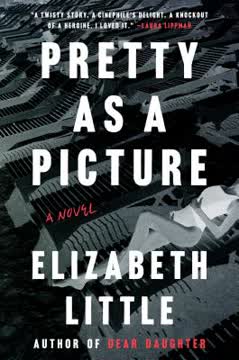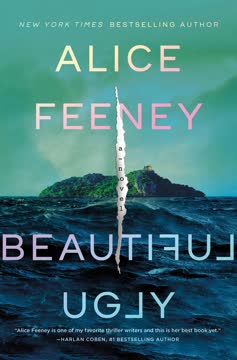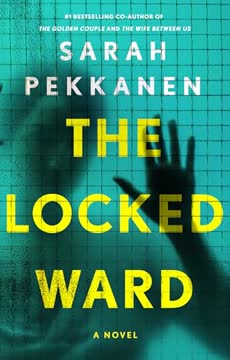Plot Summary
The Picture's Hidden Truth
Marissa Dahl, a talented but socially anxious film editor, is summoned to a mysterious Hollywood meeting. Instead of a script, she's handed a photograph: a young woman, dead on a beach, played by starlet Liza May. Marissa's sharp eye for cinematic detail exposes the scene's secrets—she deduces the woman is dead, not sleeping, and that the film is a true crime story. Her insight lands her the editing job on a high-profile, secretive movie about a real murder. The chapter sets the tone: Marissa's world is one where images hold more truth than words, and her ability to see what others miss is both her gift and her curse. The emotional undercurrent is one of longing—for connection, for meaning, for a place in a world that often feels out of focus.
Hollywood's Unraveling Invitation
Marissa is swept into the chaotic machinery of Hollywood, where urgency and secrecy reign. She learns she's replacing a fired editor on a Tony Rees film—a director infamous for his brilliance and difficulty. The project is shrouded in NDAs and mystery, and Marissa is whisked across the country to a remote island location. Her anxiety about the job, her fractured friendship with her creative partner Amy, and her own self-doubt simmer beneath the surface. The emotional arc is one of displacement and anticipation, as Marissa leaves behind the familiar for a world where the boundaries between fiction and reality, work and life, are about to blur dangerously.
Crossing the Water's Edge
Escorted by Isaiah, a stoic ex-military security specialist, Marissa travels from the mainland to Kickout Island. The ferry is out, so they bribe their way onto a private boat, captained by the enigmatic Billy Lyle. The crossing is fraught with tension—locals resent the film crew, and Marissa's unease grows. The island is both beautiful and claustrophobic, a place where everyone knows everyone, and outsiders are viewed with suspicion. The emotional tone is one of foreboding and vulnerability, as Marissa senses she's entering a closed system with its own rules, histories, and dangers.
Arrival at the Shack
The crew is housed in the grand but decaying Hingham House, known as "the Shack." Marissa meets Anjali, the sharp-tongued producer, and Gavin Davies, the troubled lead actor. The hotel is filled with cast, crew, and locals, all with their own agendas. Marissa is given strict instructions to avoid socializing and focus solely on editing. She's isolated in the projection room, surrounded by old film equipment and the ghosts of the past. The emotional arc is one of alienation and curiosity, as Marissa tries to find her footing in a world where everyone is performing, and no one is quite what they seem.
Island Tensions and Old Wounds
Marissa quickly learns that the island's history is as tangled as the film's plot. The murder of Caitlyn Kelly, the real-life inspiration for the movie, still haunts the community. Locals like Nick, now a police detective, and Billy, the former prime suspect, are wary of the film's intrusion. The crew is on edge—accidents, firings, and rumors of sabotage abound. Marissa's interactions with the teenage girls Suzy and Grace, daughters of the hotel's chefs, draw her into their amateur investigation. The emotional tone is one of simmering tension, as old wounds are reopened and new alliances form.
The Dead Girl's Movie
Marissa immerses herself in the footage, piecing together the story of Caitlyn's death. The film's script is obsessed with the victim's beauty and innocence, but Marissa sees the cracks—contradictions, missing details, and a director manipulating reality for his own ends. The process is both creative and unsettling, as Marissa's empathy for the dead girl grows. She's haunted by the parallels between the film's narrative and the real people around her, especially Billy, who remains an outcast. The emotional arc is one of growing obsession and empathy, as Marissa becomes determined to find the truth behind the fiction.
The Cast and the Locals
On set, Tony Rees pushes his actors to the brink, especially Liza May, whose resemblance to Caitlyn is uncanny. Gavin, playing the accused, struggles with the role and his own demons. The crew gossips, the locals grumble, and Marissa observes it all from the margins. Her outsider status allows her to see connections others miss—between the film's story, the island's history, and the people's pain. The emotional tone is one of mounting pressure, as the boundaries between acting and reality, guilt and innocence, begin to blur.
Secrets in the Projection Room
Late one night, Marissa is attacked in the projection room. The film's hard drives are stolen, and she's left injured and shaken. The incident throws the production into chaos and brings the police investigation to the forefront. Marissa's sense of safety is shattered, and her isolation deepens. She's forced to confront her own vulnerability and the possibility that someone on the island—crew or local—will do anything to keep the truth buried. The emotional arc is one of fear and determination, as Marissa resolves to uncover what really happened, no matter the cost.
The Past Repeats Itself
The unthinkable happens: Liza May is found dead, posed on the beach in a chilling recreation of Caitlyn's death. Panic and suspicion sweep through the hotel. The island is locked down, and everyone is a suspect. Marissa, traumatized by her discovery of the body, is drawn deeper into the investigation. The parallels between past and present become impossible to ignore, and the question of who benefits from these deaths—who is writing the story now—takes on new urgency. The emotional tone is one of shock, grief, and a desperate need for answers.
The Editor's Isolation
As the investigation intensifies, Marissa is confined to her room for her own safety. She's forced to rely on her wits, her memories, and her unlikely allies—Isaiah, Suzy, and Grace. The girls' podcast-style sleuthing provides both comic relief and genuine insight. Marissa's relationships with Amy and Isaiah deepen, revealing her longing for connection and her fear of rejection. The emotional arc is one of introspection and resilience, as Marissa confronts her own limitations and strengths.
The Girls' Investigation
Suzy and Grace, undeterred by danger, continue their investigation into both murders. They uncover inconsistencies in the official story, missing evidence, and overlooked suspects. Their youthful bravado and digital savvy complement Marissa's analytical mind. Together, they begin to piece together a new narrative—one that challenges the assumptions of both the film and the police. The emotional tone is one of hope and camaraderie, as the unlikely team finds strength in each other.
The Night of the Attack
Marissa, retracing her steps, realizes the attack on her was a cover for the theft of the footage. She and Isaiah investigate the island's caves and secret passages, uncovering evidence that points away from Billy and toward someone with intimate knowledge of both the hotel and the film. The emotional arc is one of suspense and courage, as Marissa faces her fears—of water, of darkness, of being wrong—and emerges with new clarity.
A Body on the Beach
The discovery of Liza's body throws the island into chaos. The police focus on Billy, but Marissa and her allies are convinced he's innocent. The parallels between the two deaths—both young women, both posed, both connected to Tony—become impossible to ignore. Marissa's empathy for the victims and her determination to find justice drive her to take greater risks. The emotional tone is one of grief, anger, and resolve.
The Island Locks Down
With the island sealed off, tensions among the crew and locals reach a breaking point. Old secrets surface—affairs, betrayals, and long-held grudges. Marissa, Isaiah, and the girls race to find the missing footage and the real killer before the police make a tragic mistake. The emotional arc is one of urgency and solidarity, as the team learns to trust each other and themselves.
Suspects and Motives
Marissa reviews the footage, interviews, and evidence, uncovering inconsistencies in Tony's story and the official narrative. She realizes that the killer is someone obsessed with control, with the power to shape reality—someone who sees life as a movie and people as characters. The emotional tone is one of revelation and dread, as Marissa closes in on the truth and the danger grows.
The Truth in the Footage
A careful review of the raw footage and the missing rough cuts exposes Tony's manipulations—both on set and in life. Marissa and Anjali discover that Tony orchestrated accidents to torment Liza, and that his obsession with Caitlyn and her cinematic double led him to murder. The emotional arc is one of vindication and horror, as the evidence finally matches the intuition Marissa has had all along.
The Real Story Emerges
Marissa confronts Tony in the projection room, piecing together the story of both murders. She realizes that the original death was an accident, covered up by those who loved Caitlyn, but that Tony's need for control and recognition turned tragedy into horror. The emotional tone is one of catharsis and sorrow, as the truth comes out and the cycle of violence is broken.
The Killer Unmasked
With the evidence in hand, Marissa and Isaiah expose Tony as Liza's killer. The police arrest him, and the island begins to heal. Marissa's courage and insight are recognized, but she remains haunted by the cost of the truth. The emotional arc is one of relief and exhaustion, as the survivors reckon with what they've lost and what they've learned.
Aftermath and New Beginnings
In the weeks that follow, Marissa, Suzy, Grace, and Isaiah form an unlikely family. The film is reworked as a documentary, and the island slowly returns to normal. Marissa reconciles with Amy, finds peace in her own skin, and looks to the future with cautious hope. The emotional tone is one of bittersweet acceptance and quiet triumph, as Marissa learns that imperfection is the price of loving something—and that sometimes, the story you tell yourself is the one that matters most.
Characters
Marissa Dahl
Marissa is a gifted film editor whose social anxiety and obsessive attention to detail make her both an outsider and an unlikely hero. Her relationships—with Amy, her creative partner; with Isaiah, her protector; and with the teenage sleuths Suzy and Grace—reveal her longing for connection and her fear of rejection. Marissa's psychological journey is one of self-acceptance: she learns to trust her instincts, to value her own perspective, and to find meaning in imperfection. Her development is marked by vulnerability, resilience, and a quiet, stubborn courage that ultimately cracks the case and saves lives.
Isaiah Greening
Isaiah is hired as security for the film but quickly becomes Marissa's confidant and partner in investigation. His calm, methodical approach balances Marissa's anxiety, and his own trauma and sense of duty give him depth beyond the "bodyguard" stereotype. Isaiah's relationship with Marissa evolves from professional to personal, marked by mutual respect, gentle humor, and a shared sense of being outsiders. He is both a grounding force and a catalyst for Marissa's growth, teaching her to trust herself and others.
Anjali Bhattacharya
Anjali is the film's producer and Tony's longtime collaborator. She is fiercely competent, quick-witted, and unafraid to speak truth to power. Her loyalty to the project is tested by the unfolding tragedy, and her relationship with Marissa shifts from wary skepticism to genuine partnership. Anjali's own struggles—with sexism, racism, and the pressures of Hollywood—mirror the story's larger themes of power and complicity. She ultimately chooses integrity over ambition, helping to expose the truth and protect the vulnerable.
Gavin Davies
Gavin is the film's leading man, cast as the accused killer. Haunted by his own demons and desperate for validation, he forms a bond with Marissa and the girls. His empathy for Billy and his willingness to challenge Tony's authority make him both a suspect and a hero. Gavin's psychological arc is one of redemption—he moves from self-absorption to self-sacrifice, risking his career to do what's right. His relationship with Marissa is marked by mutual recognition of their flaws and strengths.
Suzy Koh & Grace Portillo
Suzy and Grace, daughters of the hotel's chefs, are whip-smart, resourceful, and fearless. Their podcast-style investigation provides both levity and crucial breakthroughs. They represent the next generation—unafraid to question authority, skilled at navigating both the digital and real worlds, and determined to seek justice. Their friendship with Marissa is transformative for all three, teaching her to embrace imperfection and to trust in the power of unlikely alliances.
Tony Rees
Tony is the film's director and the story's central antagonist. Brilliant, obsessive, and emotionally remote, he is both a creator and a destroyer. His need for control, his manipulation of actors and reality, and his inability to distinguish art from life drive the narrative's tragedies. Tony's relationships—with Anjali, with Liza, with the island—are marked by exploitation and betrayal. His psychological unraveling is both horrifying and pitiable, a cautionary tale about the dangers of unchecked power and ego.
Billy Lyle
Billy, the boat captain and former murder suspect, is the island's perennial outsider. Socially awkward, gentle, and deeply wounded by years of suspicion, he is both a red herring and a symbol of the story's central themes: the cost of otherness, the dangers of easy answers, and the possibility of redemption. Billy's friendship with Marissa and the girls is a lifeline, and his ultimate exoneration is both a victory and a reminder of the damage done by collective fear.
Liza May
Liza is both the star of the film and its second victim. Her resemblance to Caitlyn, her struggles with Tony's demands, and her vulnerability make her a tragic figure. Liza's death is the catalyst for the story's climax, forcing the characters to confront the consequences of their actions and the dangers of mythologizing victims. She is both a person and a symbol, a reminder that behind every story is a real life lost.
Nick Decker
Nick, now a detective, was once Tony's friend and part of the island's insular community. His investigation is hampered by old loyalties, guilt, and a desire to do things "right" this time. Nick's relationship with Marissa is adversarial but ultimately respectful, as he learns to listen to outsiders and question his own assumptions. He represents the limits of institutional justice and the need for personal accountability.
Amy Evans
Amy, Marissa's longtime collaborator, is a successful director and the person who knows Marissa best. Their friendship is tested by distance, jealousy, and unspoken feelings, but ultimately endures. Amy's support, honesty, and willingness to challenge Marissa are crucial to her growth. She embodies the story's message that love—messy, imperfect, and hard-won—is worth fighting for.
Plot Devices
Blurring of Fact and Fiction
The novel's central device is the interplay between film and reality. Marissa's role as editor mirrors her role as detective—both require piecing together fragments, questioning narratives, and seeking meaning in chaos. The film-within-the-book, based on a real murder, becomes a lens through which the characters (and readers) examine the nature of truth, memory, and storytelling. The use of raw footage, rough cuts, and missing scenes serves as both literal evidence and metaphorical commentary on the ways we construct and reconstruct reality.
Unreliable Narration and Perspective
The story is told through Marissa's anxious, self-deprecating perspective, but is interspersed with podcast transcripts, interviews, and other voices. This multiplicity of viewpoints creates ambiguity and suspense, forcing readers to question what is real, what is performance, and who can be trusted. The device also allows for humor, meta-commentary, and a deep exploration of character psychology.
Locked-Room Mystery and Isolation
The island setting, the hotel's labyrinthine corridors, and the lockdown after the murders create a classic closed-circle mystery. Characters are trapped—by geography, by suspicion, by their own secrets. This device amplifies the stakes, intensifies relationships, and forces confrontations that might otherwise be avoided. The isolation also mirrors Marissa's internal struggles, making her eventual breakthroughs all the more powerful.
Foreshadowing and Parallelism
The novel is rich in foreshadowing—early accidents, missing details, and repeated motifs (mirrors, doubles, performance) all point toward the eventual revelation. The parallel deaths of Caitlyn and Liza, the repetition of poses and costumes, and the echoes between the film's script and real events create a sense of inevitability and tragedy. The device underscores the dangers of mythologizing victims and the ways in which stories, once set in motion, can take on lives of their own.
Meta-Narrative and Self-Reflection
The book is deeply self-aware, constantly commenting on its own construction and the nature of narrative. Marissa's editing process becomes a metaphor for living—choosing what to keep, what to cut, how to make sense of the mess. The podcast transcripts, film references, and direct addresses to the reader invite us to question our own roles as consumers of stories, and to recognize the power—and responsibility—of those who shape them.
Analysis
Pretty as a Picture is a razor-sharp, darkly funny deconstruction of the murder mystery, the Hollywood machine, and the stories we tell ourselves to survive. At its core, the novel is about the search for truth in a world obsessed with appearances—where every image is curated, every narrative is suspect, and every person is both actor and audience. Through Marissa's anxious, incisive gaze, Elizabeth Little explores the dangers of mythologizing victims, the corrosive effects of power and complicity, and the redemptive potential of connection and self-acceptance. The book's structure—blending traditional whodunit with meta-commentary, podcast transcripts, and film theory—invites readers to question not just who did it, but why we care, and what it means to bear witness. Ultimately, Pretty as a Picture is a celebration of imperfection, a call to embrace the messy, unfinished stories that make us human, and a reminder that sometimes, the most important truths are the ones we find in the editing room of our own lives.
Last updated:
Review Summary
Pretty as a Picture is a character-driven mystery featuring Marissa Dahl, a socially awkward film editor. Set on an isolated island during a movie shoot, the story combines humor, film industry insights, and a murder investigation. Readers praised Marissa's unique voice and the witty dialogue, though some found the mystery predictable. The book's pacing and tone divide opinions, with some enjoying its lighter approach to the thriller genre, while others found it slow or confusing. Overall, it's an entertaining read for those who appreciate quirky characters and movie references.
Similar Books
Download PDF
Download EPUB
.epub digital book format is ideal for reading ebooks on phones, tablets, and e-readers.









